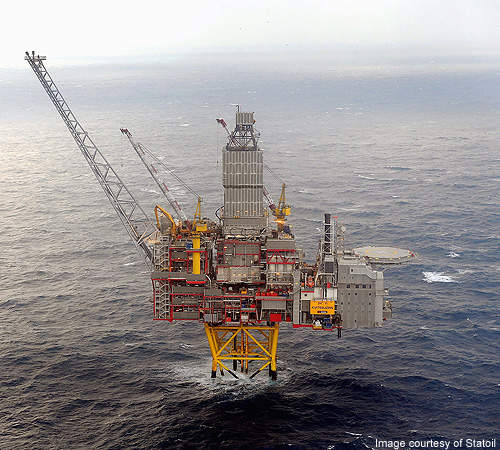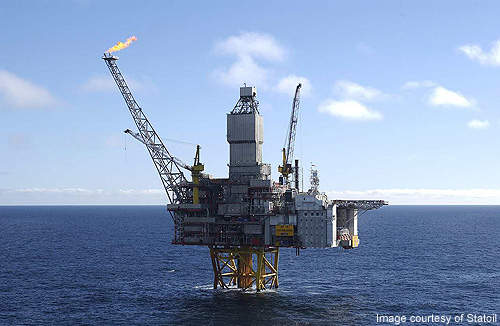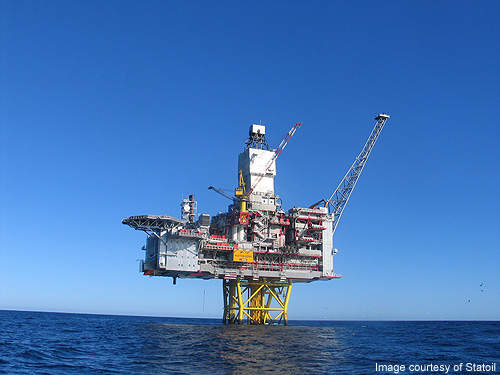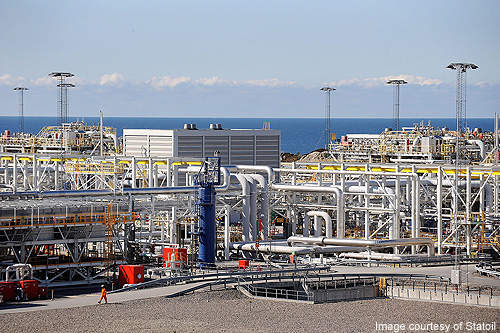Kvitebjørn field is situated in block 34/11 of the Tampen area in the North Sea, Norway. The gas and condensate field lies at a water depth of 190m.
The field is owned by operator Statoil (39.55%), Petoro (30%), Centrica (19%), Enterprise Oil Norge (6.45%) and Total (5%). A total of Nrk10bn was invested in the development of the field. First production was achieved in September 2004.
In 2014, a new compressor module was installed at the field to increase the recovery rate at the field from 55% to 70%, which is expected to extend the field’s lifespan by eight years from 2027 to 2035.
Discovery
The Kvitebjørn field was discovered in 1994 by the discovery well 34/11-1.
Geology and reserves
The Kvitebjørn field is of the Middle Jurassic Age and is situated at a depth of 4,000m. The high temperature and pressure reservoir consists of sandstones of the Brent Group formation.
Estimated recoverable reserves at the field were initially 55 billion cubic metres (bcm) of gas and 132 million barrels of condensate. However, the reserve estimates were upgraded by approximately 50% in 2006, to 84bcm of gas and 202 million barrels of condensate.
Field development
Production drilling began in September 2003. The field development programme included a total of 11 production wells and one disposal well. By 2009, nine wells were drilled and in production.
Kvitebjørn platform
Production is being carried out using an integrated drilling and processing platform installed at a depth of 190m. The platform is supported by a 220m-tall two-section steel jacket weighing 18,000t. The topside of the platform is 40m-high, 100m-long and 45m-wide, and weighs 11,000t.
The platform also features a six-storey-high living module weighing 1,200t. The module includes 95 berths, a kitchen, lifeboats and additional facilities.
The deck was installed by a Saipem 7000 crane vessel in May 2003.
Production
The gas and condensate are recovered using pressure depletion. Drill cuttings and produced water are injected into the disposal well.
Statoil installed a new compressor on the field to boost production by 220 million barrels of oil equivalent. Installation of the compressor was carried out between 2012 and 2014. The 1,000t compressor module was lifted into place in mid-2013.
Production was interrupted in 2008 due to a gas leakage 10km from the platform. The production resumed after the pipeline was repaired. TDW Offshore Services designed and installed a special subsea clamp system to repair the pipeline.
Processing systems
Gas recovered from the field is sent to the Kollsnes facility near Bergen through a gas pipeline. At the Kollsnes plant, dry gas and natural gas liquids (NGL) are separated. The dry gas is carried to Europe and the NGL is sent to the Vestprosess plant at Mongstad for further processing.
Condensate is also sent for processing to the Vestprosess plant via the Kvitebjørn oil pipeline.
Pipeline
The Kvitebjørn gas pipeline is 150km-long and has a diameter of 30in. The 90km-long Kvitebjørn oil pipeline runs from the platform to Troll Oil Pipeline II and has a diameter of 16in.
Contracts
In November 2010, the Bergen Group Rosenberg (now Rosenberg Worley Parson Group) won an Nrk1.5bn contract to manufacture and install a new compressor module on the Kvitebjørn platform. Bergen carried out the project in partnership with Fabricom. The compressor module increases the recovery rate and accelerates field production.
Procon Drilling Services was awarded an Nrk300m contract to drill production wells at the field.
Aker Verdal won an Nrk600m contract to build the jacket for the Kvitebjørn platform. Umoe Olje og Gass constructed the main topside of the platform under a Nrk2bn contract.
Leirvik Module Technology was awarded an Nrk230m contract for building the living quarters on the Kvitebjørn platform.
An Nrk124m contract was awarded to ABB Offshore Systems to construct and install the deck and processing facilities of the platform.
Italy-based Ilva supplied 54,000t of steel pipe for the Kvitebjørn gas pipeline under an Nrk270m contract. Steel for the Kvitebjørn Oil Pipeline was supplied by Corus Tubes steelworks under an Nrk100m contract.
Allseas Marine Contractors was awarded an Nrk300m contract to install the gas and condensate pipelines.
A surface treatment contract worth Nrk140m was awarded to Bredero Price Norway to coat the gas and condensate pipelines with asphalt and concrete.
Saipem was awarded an Nrk100m contract to connect the gas and condensate pipelines with the Kvitebjørn platform. The company was also responsible for transportation and installation of the jacket and topsides of the platform.












